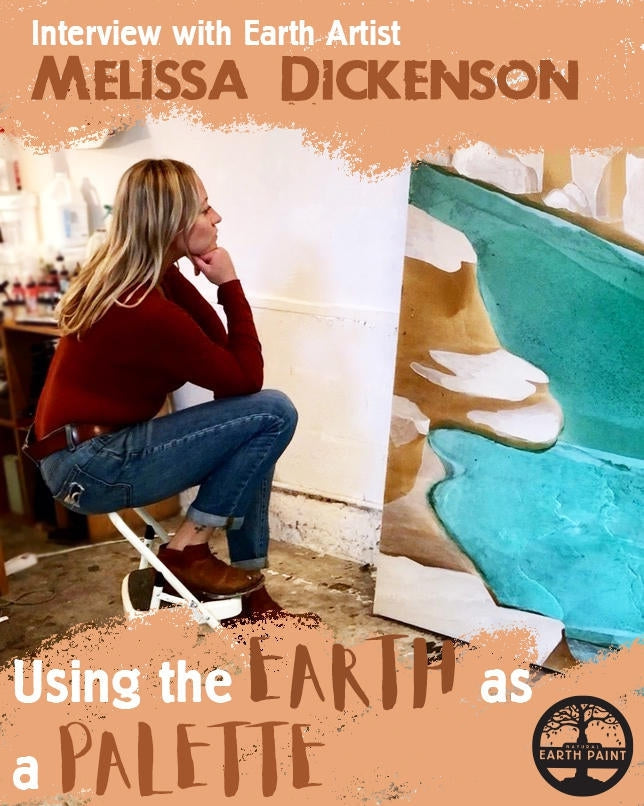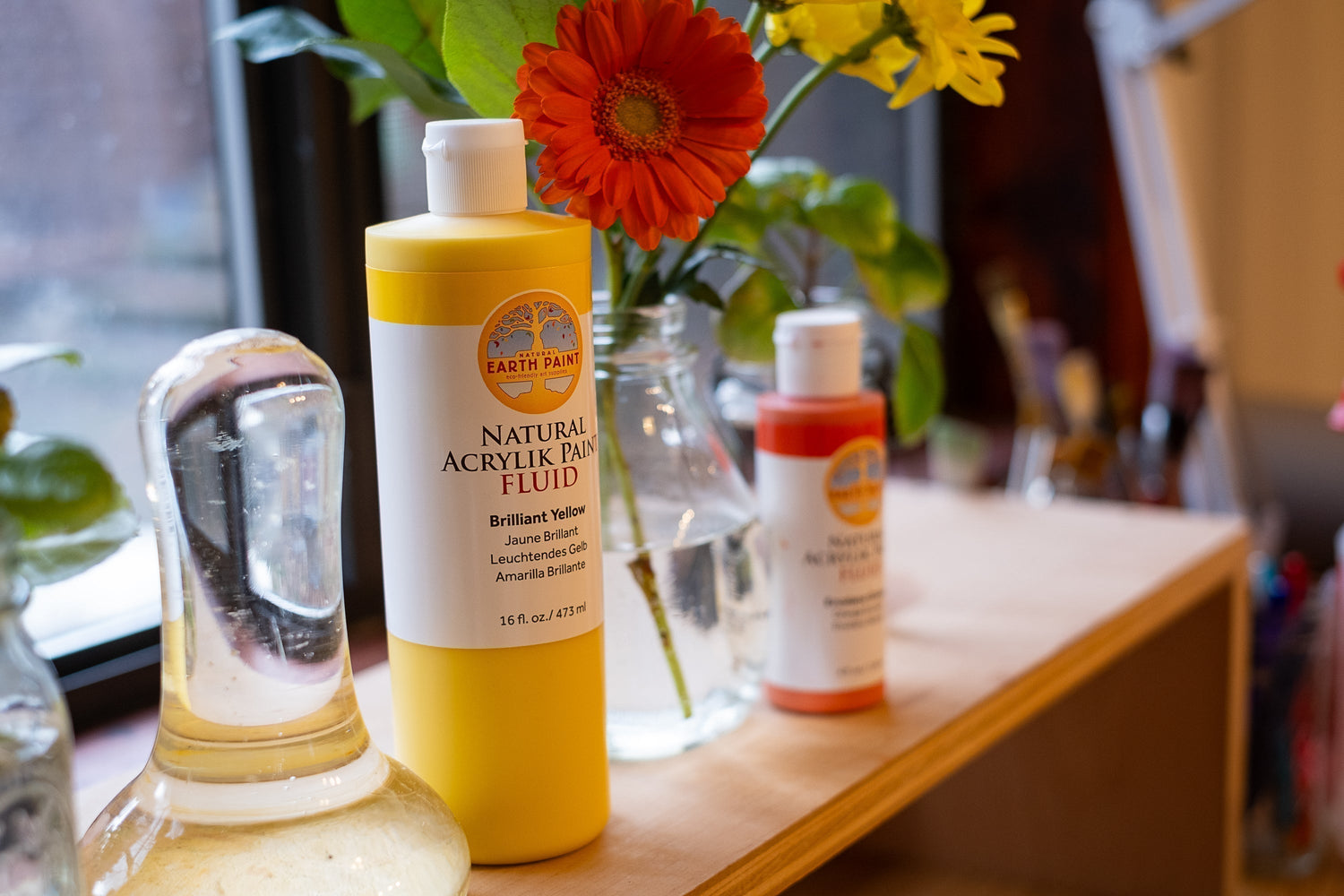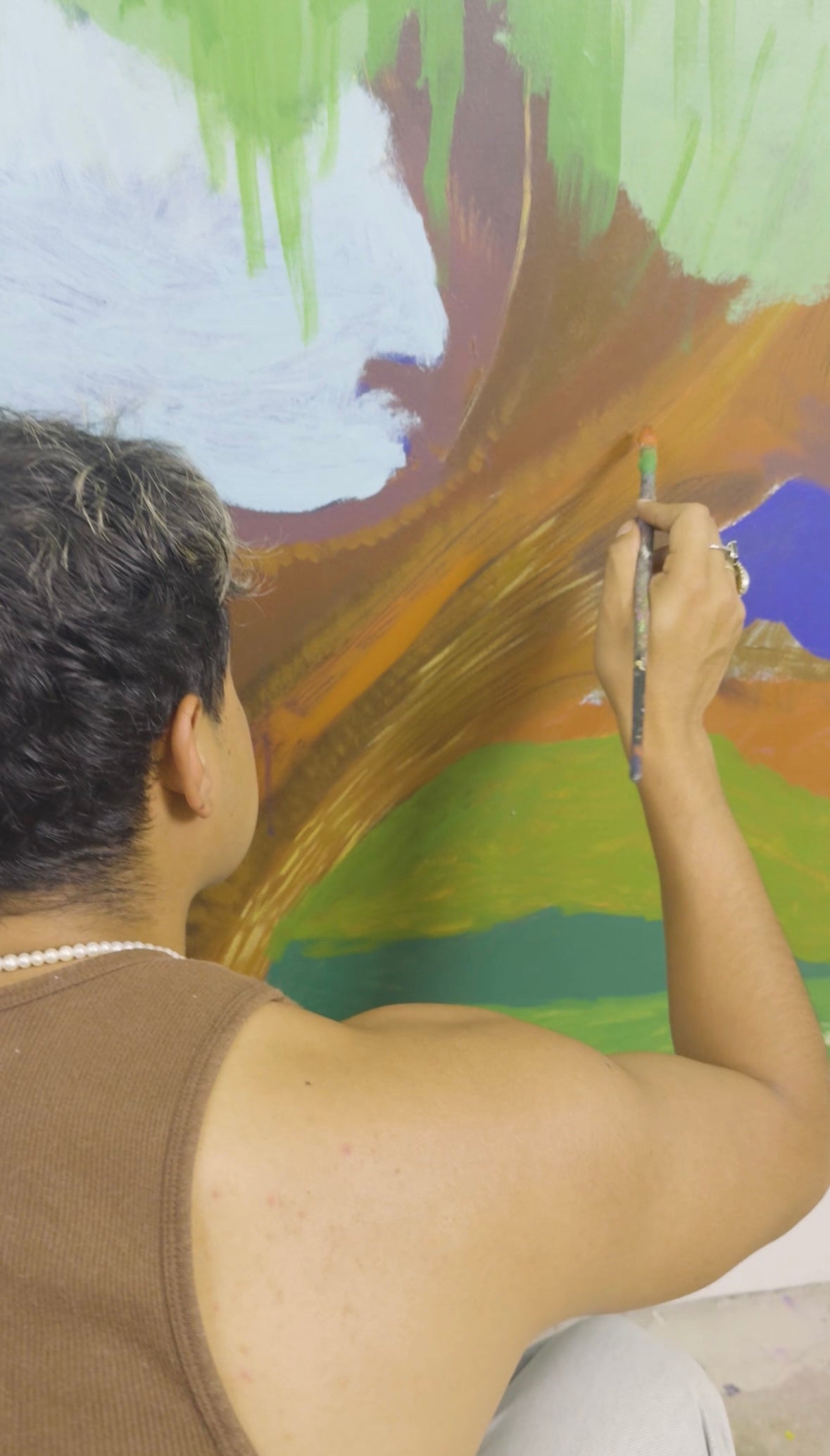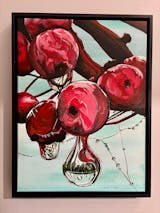Melissa is one of my favorite contemporary artists today and I am so excited to feature her breathtaking earth-based work here. She is based in San Francisco and during a recent visit to her beautiful studio we got to geek out on our mutual passions for harvesting pigments in nature. Her fascinating process of pouring the liquified crushed pigments across a canvas on the floor creates stunning imagery that I've never seen before.
Thank you so much, Melissa, for taking the time to share your experiences with us! Can you start by telling us a little bit about your personal history - where you grew up and how did that place or landscape affect your life as an artist?
Hi Leah, I’m so excited to chat! Let’s see, I was born in New Mexico but my parents split up when I was two and my mother, sister and I moved to Boston to be closer to my Mom’s side of the family. We lived in a small apartment so as far as landscape goes it was pretty limited. My mom was really good about taking us out to some kind of nature on the weekends. We actually lived really close to Walden Pond (of Henry Thoreau fame) growing up so we spent a lot of time there in all seasons hiking, playing in the trees, throwing snow, jumping in leaves and imagining what the remnants of old structures could have been. I still think the forest is such a magical place with all of it’s moods and because we didn’t have a backyard growing up, the woods became a very special place of possibility and imagination for me.
It wasn’t until college that I went back to New Mexico to visit my Dad that I got to experience the game changer that terrain is. To this day, every time I visit NM I am in awe of its beauty and all of it’s colors, it’s really quite amazing!... I feel really connected to the landscape...maybe because I was born in NM it seems to speak so loud and clear to me even though I didn’t grow up there.

What art training did you receive?
I got my BFA at Maryland Institute College of Art in Baltimore, MD and my MFA at California College of the Arts in San Francisco, CA
In your art training, were you ever taught about art supplies safety - How to protect yourself from toxic supplies and which supplies were toxic?
HAHAHA! Absolutely not! I think the only thing I was taught int he 1 painting class I took in undergrad was not to put your turpentine in a drinking vessel so you wouldn’t accidentally drink it instead of your coffee. Yeah, there was not a lot on safety education in the late 90’s as far as chemicals go.
What types of paint and supplies did/do you primarily use and what were/are your safety precautions?
I used to make paintings out of plastic film. I would make giant paintings like 8’ x 9’ using various plastic sheets or plastic drop clothes, or mattress covers stretching them as you would canvas 20-30 layers deep. Sometimes I would sandwich paint in between layers of the plastic and put my body weight on the paint to manipulate it. I didn’t really think about “safety” because my body was never touching paint, but I realized that all of the BPA’s and other chemical seeping into my swing from literally throwing myself on the plastic could be a problem in the future.

Did you have any adverse health issues from using these supplies?
Not immediately, but about seven years ago, I had been reading a lot about plastic and health and realized I was putting myself at risk of developing problems in the future.
Now, I work on raw canvas and find all of my pigments foraging or procuring natural minerals from the earth. When I am pounding and grinding minerals down to a powder form I always wear a respirator, goggles and apron. If I am using a more powerful mineral like Malachite I add in the extra protection of gloves and a smock as well and I shower immediately after the studio.
How were you first introduced to making your own paints from natural earth and minerals?
When I decided to switch from plastic paintings to raw canvas I was still using store bought acrylics. Using my body weight to manipulate the paint into abstract paintings that always had a landscape kind of vibe. I kept having this urge to paint outside so I could pick up the form of the ground underneath my body but my paintings were so large that if I did that anywhere in nature I’d have to leave it there for a few days to let it dry before getting back to the studio and that wasn’t possible without making a lot of folks mad and or loosing a piece to the wind or just someone taking it. I took a trip to Joshua tree for my 38th Birthday..... and it was there that I had the idea to bring the landscape into my paintings instead of my paintings into the landscape. I filled a little jar of dirt while on a hike out in the desert... came home and thing just evolved from there.

How do you incorporate natural materials into your art process?
The procuring of pigment is a very big part of the art making process right now. When I forage for pigment, the images that are made after are derived from the place in which their pigments are found. My paintings are portraits in a way of the land in which their pigments are found. I use a lot more photography and do a lot more planning of composition that I have ever done previously.
How does the act of harvesting your materials in nature and making your own supplies affect your painting process?
It has made it way more interesting and a lot more challenging.
What’s your favorite thing about finding and collecting paint supplies in nature?
I love looking at the earth in a new more meticulous way. I notice subtle color in soil and rocks I wouldn't have notice before my practice shifted to natural pigments. I look at the minute for pigment and the macro for landscape composition. It’s quite a process, visiting a place, seeing its unique terrain , hiking it and feeling its textures. Gathering what the earth has to offer visually and physically is such a soothing practice, maybe even a little self indulgent. Sometimes there isn’t pigment to be found but a place is so beautiful that I’ll take a ton of photos and allow myself the artistic license to use pigment from another space and time to create an abstract composite place.

Do you have any tips for artists who also want to harvest their own pigments or detoxify their studio? Were there any challenges? What made the process easier? What have the benefits been?
I’d say take your time and don’t try to do it all at once. Start with one product, then when you are replacing items in your studio. Go the natural route, it might be a little more expensive in the end but it’ll be worth it for you and the environment’s longevity. I removed things little by little and added non toxic things little by little. It takes patience.
Which artists throughout time inspire you the most?
This might sound weird but I’m gonna go there anyway..... Eva Hesse. She was an amazing and tragic artist. I was really into her work when I was in grad school, at the time I was working with a lot of plastics as I mentioned before. Hesse is famous for her use of ethereal materials such as plastic, latex, fiberglass and other toxic materials for her sculptures. I’m not a doctor, but she got brain cancer at age 34, Eva’s story got methinking about the material safety in a very real way and that’s when I started to make my slow shift.
What is the main inspiration for your work?
Connection of the body/self to a physical place.

How do you find balance and stay connected to the natural world in the typically disconnected, busy-ness of todays world?
I live in San Francisco, which is pretty darn busy as far as cities go, so I get out of town most weekends to hike around California or do foraging trips. I also ride my bike in the city and use a car only when I travel... that keeps me outside as much as possible!
How would you describe your artistic style?
Hmmmm, I’d consider myself an abstract landscape painter.

We at Natural Earth Paint are hoping to inspire a "Slow Art Movement" and encourage artists to slow down their process and take the time to hone their craft, create their own art materials like the Old Masters, and develop a real connection with their process - allowing the inspiration to come at it's own time and taking the time needed to create it. This reminds me of your work, does this resonate with you at all?
Oh, absolutely! I think there is this shift happening in almost every field not just art. Food, fashion, farming, diet/health, community and life in general. I think people are going back to what our ancestors knew inherently .... that it’s all about the journey and taking time to really support artistry and techniques that are not machine produced.

Tell us about any upcoming shows or how can we see more of your art?
I have two shows coming up in 2020... A solo show at K. Imperial Fine Art in San Francisco and a group show about climate change and climate called “Nature Refract” at the Gualala arts Center in Gualala, CA October 2020.
You can find Melissa's work at www.melissadickenson.com
Interested in learning more about Natural Earth Paint artists? Visit our Eco Artists page!
Follow us on Instagram, Facebook, and Pinterest for more natural inspiration.







